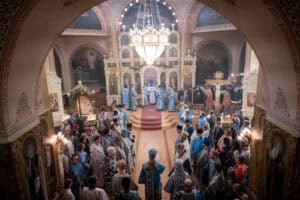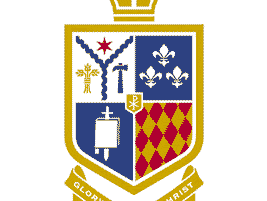By Fr. Steven Kostoff.
Yesterday evening, fifteen members of our parish sat in a relatively empty cinema and together watched an amazing film – “The Man of God.” Everything about the film was of the highest quality – the script, the acting, the recreation of late 19th – early 20th c. Egypt and Greece, the musical score, and a fine eye from the director for the larger narrative and those details that leave a lasting impression. The director, by the way, is Yelena Popovich, a Serbian-American, who is an Orthodox believer. She has made a film unapologetically focusing on a “holy man” (the actual meaning of the word “saint”) of deep faith and piety – St. Nektarios of Aegina (+1920) The Orthodox scholar, Constantine Cavarnos has described St. Nektarios in the following manner: “Metropolitan of Pentapolis, great Theologian, Philosopher, Moralist, Educator, Ascetic, Mystic, Miracle-Worker and Healer.” His written legacy is quite prolific.
St. Nektarios was a Greek Orthodox bishop (Pentapolis in Egypt) who was mercilessly mistreated and slandered by his fellow hierarchs in both Egypt and Greece. His life as a bishop became almost a struggle for survival as he never received a diocese once he was expelled from Egypt by Patriarch Sophronios in the late 19th c., still a relatively young man. This broken relationship between St. Nektarios and the patriarch was especially painful to him, as the patriarch was his “spiritual father.” Slander followed him to Greece and the wheels of the ecclesiastical bureaucracy never moved in such a way that would soften his initial fall from grace, thus leaving him not only unrecognized, but isolated and humiliated.
He eventually became the rector of a prominent theological school, however, building it up as young men were trained for both service in the Church and in the world. Even here there were real tensions with more secularly-minded authorities. His approach was to find the right balance between “kindness and authority.” His last great vocation was to establish a group of young nuns in an independent monastery on the lonely island of Aegina. (Today, this is a large and thriving monastic community and complex.) But he died misunderstood and isolated from the wider life of the Orthodox Church in Greece. In his lifetime, there was no final reconciliation between the saint and the Church hierarchy. (This was the fate of St. John Chrysostom from the fourth and fifth centuries). Duriing his lifetime, he was a prolific writer of theological and pastoral literature that is in wide circulation to this day. His holiness could not remain hidden, and he was numbered among the saints of the Church in 1961. The Patriarchate of Alexandria issued a formal apology a few decades after his death, and this flowery apology scrolled down across the screen right before the final credits. Often, the Church is too hesitant to admit a mistake and repent, so this was a fine example of breaking through such self-defensive posturing.
The film’s focus was on the interior life of St. Nektarios as he absorbed blow after blow that would have totally diminished a man of lesser integrity and lesser faith. It was precisely the depth of his faith, his acceptance of whatever cross that came his way – uninvited though it may have been – and his acceptance of any and all life-constricting situations always as a hidden and providential means of strengthening his sense of total dependence on God. This was overwhelmingly impressive as the film unfolded. He always exhorted those around him to resort to faith in God in trying circumstances.
The lead actor playing St. Nektarios did bring a genuine sobriety and dignity to his portrayal, never falling into the level of pietistic sentimentality. The dialogue was sharp and focused and the saint showed great restraint when verbally – and once even physically – assaulted by his detractors. St. Nektarios leaned on the Gospel image of Christ, turning his other cheek at times, but as Dostoevsky once wrote: “Humility is a powerful force.” One touching element is that his supporters were far more troubled at the indignities that he suffered, than St. Nektarios himself was. They wanted justice on his behalf, but he realized that it was not forthcoming. Of particular interest is that the only time St. Nektarios was willing to “fight” the authorities, is when his spiritual children – a group of young nuns – were under attack.
The atmosphere of his time period was nicely brought to life, from late 19th c. sensibilities – both ecclesial and secular – to the speech patterns and clothing different people wore. The film was made in English and at times the accents were (attractively) heavy! There was some nice interior shots of what were clearly Byzantine-era churches. The saint’s practice and dependence on the Jesus Prayer was also periodically highlighted. On the whole, this film was a very professional production, and not a film that could only aspire to playing time on “religious media channels.” The question may arise: Can genuine holiness – or an actual historical saint – be depicted in a film, itself a construct that is ultimately imaginative? That is a legitimate question, indeed. But here was an honest attempt that did strive to remain within realistic boundaries and discernible facts from the life of St. Nektarios – with what I would again call a certain “sobriety” – without straying into the excesses of romanticized religiosity.
Following the film everyone seemed a bit stunned, trying to process what we had just seen in the life of this remarkable man. To a person, everyone from the parish seemed quite moved and impressed. (The near-empty theatre was a bit disconcerting. I had expected a different response from the Orthodox Christian community). We had some lively exchanges before we left the theatre. Someone even suggested a “road trip” to Aegina one day! That is where the relics of St. Nektaroios are resting and widely venerated to this day. His feast day is November 11, and is on the OCA ecclesiastical calendar.
I know that “The Man of God” will be shown next Monday, March 28. I am aware of other parishioners who intend on viewing the film. I would strongly recommend it to anyone else. It is a good choice for a “lenten-time film.” Actually, presvytera and I saw the film in the summer. We missed the first twenty minutes or so, and on a small computer, we did not have the same viewing experience as this time. We thought it was “good” but nothing exceptional. This second viewing was quite a different experience.
If you saw it yesterday evening at a different theatre – I believe four different cinemas are presenting it – please share your impression with me. I ask the same if you view it next Monday. I am also thinking of an upcoming zoom session after next Monday, in which we could have a lively group discussion.




